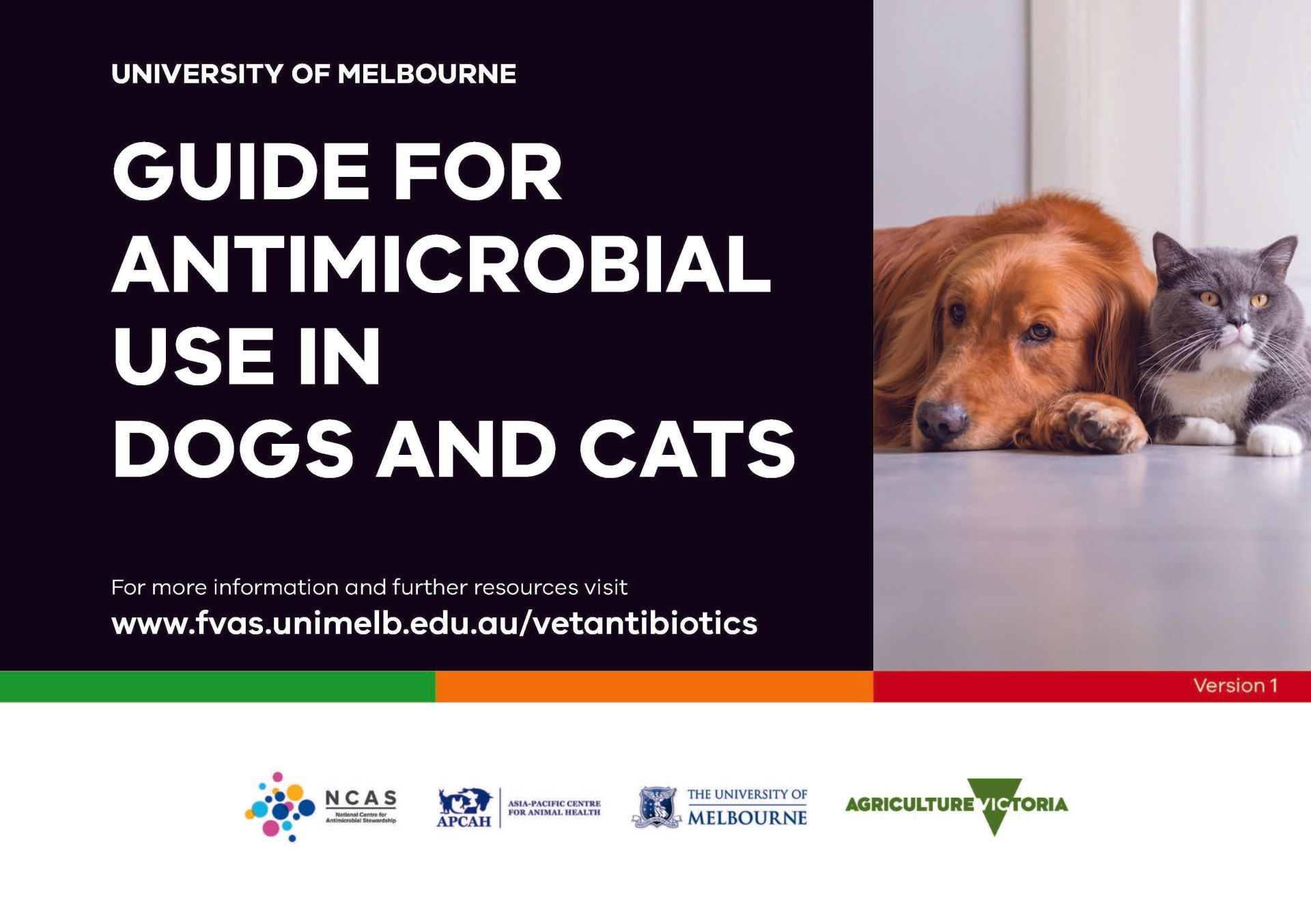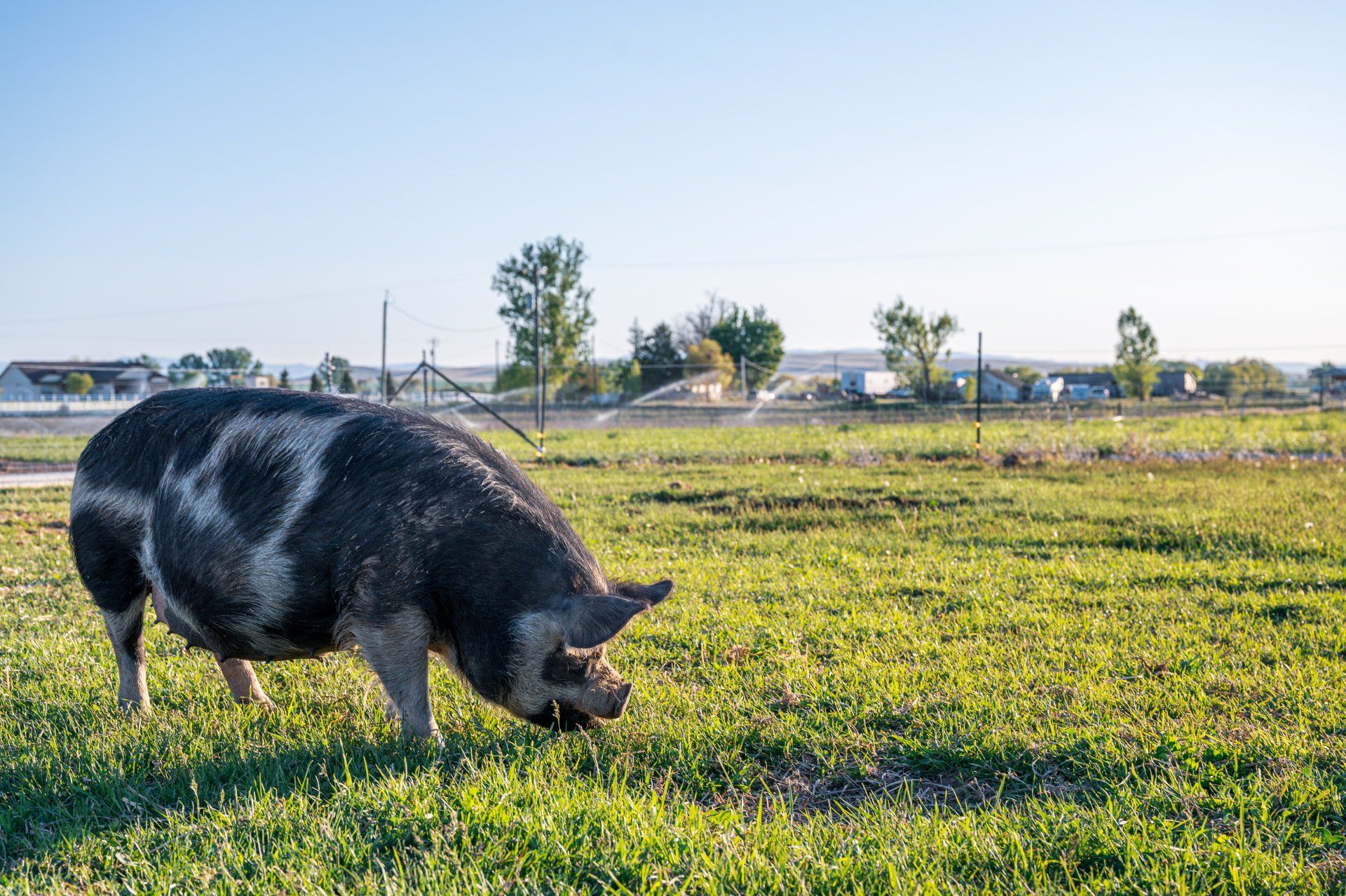Resources for Veterinarians
Australian Veterinary Prescribing Guidelines and resources

The Australian veterinary prescribing guidelines are evidence-based guidelines that have been created in a collaborative effort between the University of Melbourne’s Asia Pacific Centre for Animal Health (APCAH) and the National Centre for Antimicrobial Stewardship. These guidelines are not static and we hope that you will also take an active role in this evolutionary process. Our resources include online guidelines, pocketbooks, charts and posters.

by NCAS
•
18 Nov, 2021
Karin A Thursky, Laura Y Hardefeldt, Arjun Rajkhowa, Courtney Ierano, Jaclyn Bishop, Lesley Hawes, Ruby Biezen, Sajal K Saha, Leslie Dowson, Kirsten E Bailey, Ri Scarborough, Stephen B Little, Fiona Gotterson, Brian Hur, Anna Khanina, Karen Urbancic, Helen K Crabb, Suzanna Richards, Anna Sri, Rodney James, David C M Kong, Caroline Marshall, Danielle Mazza, Trisha Peel, Rhonda L Stuart, Jo-Anne Manski-Nankervis, N Deborah Friedman, Noleen Bennett, Thomas Schulz, Helen Billman-Jacobe, Evette Buono, Leon Worth, Ann Bull, Michael Richards, Darshini Ayton, James R Gilkerson, Glenn F Browning, Kirsty L Buising, National Centre for Antimicrobial Stewardship Abstract Antimicrobial stewardship (AMS) in Australia is supported by a number of factors, including enabling national policies, sectoral clinical governance frameworks and surveillance programmes, clinician-led educational initiatives and health services research. A One Health research programme undertaken by the National Centre for Antimicrobial Stewardship (NCAS) in Australia has combined antimicrobial prescribing surveillance with qualitative research focused on developing antimicrobial use-related situational analyses and scoping AMS implementation options across healthcare settings, including metropolitan hospitals, regional and rural hospitals, aged care homes, general practice clinics and companion animal and agricultural veterinary practices. Qualitative research involving clinicians across these diverse settings in Australia has contributed to improved understanding of contextual factors that influence antimicrobial prescribing, and barriers and facilitators of AMS implementation. This body of research has been underpinned by a commitment to supplementing ‘big data’ on antimicrobial prescribing practices, where available, with knowledge of the sociocultural, technical, environmental and other factors that shape prescribing behaviours. NCAS provided a unique opportunity for exchange and cross-pollination across the human and animal health programme domains. It has facilitated synergistic approaches to AMS research and education, and implementation of resources and stewardship activities. The NCAS programme aimed to synergistically combine quantitative and qualitative approaches to AMS research. In this article, we describe the qualitative findings of the first 5 years. Read the full paper here . Citation : Thursky, K. A., Hardefeldt, L. Y., Rajkhowa, A., Ierano, C., Bishop, J., Hawes, L., Biezen, R., Saha, S. K., Dowson, L., Bailey, K. E., Scarborough, R., Little, S. B., Gotterson, F., Hur, B., Khanina, A., Urbancic, K., Crabb, H. K., Richards, S., Sri, A., James, R., Kong, D. C. M., Marshall, C., Mazza, D., Peel, T., Stuart, R. L., Manski-Nankervis, J.-A., Friedman, N. D., Bennett, N., Schulz, T., Billman-Jacobe, H., Buono, E., Worth, L., Bull, A., Richards, M., Ayton, D., Gilkerson, J. R., Browning, G. F., Buising, K. L., & National Centre for Antimicrobial, S. (2021). Antimicrobial stewardship in Australia: the role of qualitative research in programme development. JAC-Antimicrobial Resistance, 3(4), dlab166. DOI: https://doi.org/10.1093/jacamr/dlab166 .

by NCAS
•
15 Nov, 2021
Stephen Little, Andrew Woodward, Glenn Browning and Helen Billman-Jacobe Summary The piped water systems within buildings on pig farms provide pigs with continuous access to drinking water, and on many farms are also used for short periods to medicate growing pigs with antibiotics to help keep them healthy and productive. We surveyed managers of 25 medium to large pig farms across eastern and southern Australia to investigate critical elements of the design and management of water systems that impact water provision to pigs. We found wide variation in the configuration, length, and pipe materials and diameters of water systems in buildings across farms. In many buildings, main pipelines were larger in diameter than required. While this helps ensure that drinkers always provide plenty of water to pigs, it means water flows through pipes very slowly. We also found that in many buildings the number of pigs per drinker was above the recommended maximum, cleaning and disinfection of water systems was not done on many farms, and few managers were aware of the risks to water quality and pig health. We have identified important aspects of water provision to pigs for which recommendations could be added to industry guidelines used by pig farm managers. Abstract Drinking water distribution systems (WDSs) within buildings on pig farms have critical elements of their design and management that impact water provision to pigs, water quality, the efficacy of in-water antimicrobial dosing, and, thus, pig health and performance. We used a mixed-methods approach to survey managers of 25 medium to large single-site and multi-site pig farming enterprises across eastern and southern Australia. We found wide variation in the configuration (looped or branched) and total length of WDSs within buildings across farms and in pipe materials and diameters. Within many conventional buildings and some eco-shelters, WDSs were ‘over-sized’, comprising large-diameter main pipelines with high holding volumes, resulting in slow velocity water flows through sections of a WDS’s main pipeline. In over half of the weaner buildings and one-third of grower/finisher buildings, the number of pigs per drinker exceeded the recommended maximum. Few farms measured flow rates from drinkers quantitatively. WDS sanitization was not practiced on many farms, and few managers were aware of the risks to water quality and pig health. We identified important aspects of water provision to pigs for which valuable recommendations could be added to industry guidelines available to pig farm managers. Read the full paper here . Citation : Little, S., Woodward, A., Browning, G., & Billman-Jacobe, H. (2021). Water distribution systems in pig farm buildings: critical elements of design and management. Animals, 11(11). DOI: https://doi.org/10.3390/ani11113268 .

by NCAS
•
29 Oct, 2021
Ri Scarborough, Laura Hardefeldt, Glenn Browning and Kirsten Bailey Abstract Despite the important role of antimicrobial use in companion animals in the global challenge presented by antimicrobial resistance (AMR), very few studies have quantified pet owner factors that can contribute to suboptimal veterinary antimicrobial use. We conducted an online survey of pet owners, asking about their experiences with veterinarians, their opinions on antibiotic use and knowledge of antibiotics, and their communication preferences regarding judicious prescribing. Just over half (54%) of the 558 pet owners had received antibiotics for their pet at their last non-routine veterinary consultation and most owners were happy (83%) with the antibiotic prescribing decision of their veterinarian. A quarter (25%) indicated that they had been surprised, disappointed or frustrated when a veterinarian had not given their pet antibiotics; 15% had explicitly requested them. Owners placed a higher priority on their pet receiving the most effective treatment than on treatment being cheap or convenient. Most respondents recognized the limitations of antibiotic therapy and the risks associated with antibiotic use, but 50% believed the risks were confined to the treated animal; only a minority was aware of inter-species transfer of bacteria. Pet owners indicated that they would find judicious prescribing messages focused on the direct risks of antibiotics to their pet more compelling than those about public health. Our findings suggest that veterinary communications about responsible antibiotic use should focus on pet owners’ priorities and address or bypass their gaps in understanding regarding antibiotic resistance. Read the full paper here . Citation : Scarborough, R., Hardefeldt, L., Browning, G., & Bailey, K. (2021). Pet owners and antibiotics: knowledge, opinions, expectations, and communication preferences. Antibiotics, 10(11). DOI: https://doi.org/10.3390/antibiotics10111326 .

by NCAS
•
21 Aug, 2020
Laura Hardefeldt, Brian Hur, Karin Verspoor, Timothy Baldwin, Kirsten E Bailey, Ri Scarborough, Suzanna Richards, Helen Billman-Jacobe, Glenn Francis Browning and James Gilkerson Abstract Background: Cefovecin is a long-acting third-generation cephalosporin commonly used in veterinary medicine. Third-generation cephalosporins are critically important antimicrobials that should only be used after culture and susceptibility testing. The authors describe the common indications for cefovecin use in dogs and cats, and the frequency of culture and susceptibility testing. Materials and methods: A cross-sectional study was performed using clinical records extracted from VetCompass Australia. A previously described method was used to identify records containing cefovecin. The reason for cefovecin use was annotated in situ in each consultation text. Results: Over a six-month period (February and September 2018), 5180 (0.4 per cent) consultations involved cefovecin administration, of which 151 were excluded. Cats were administered cefovecin more frequently than dogs (1.9 per cent of cat consultations and 0.1 per cent of dog consultations). The most common reasons for cefovecin administration to cats were cat fight injuries and abscesses (28 per cent) and dermatitis (13 per cent). For dogs, the most common reasons for cefovecin administration were surgical prophylaxis (24 per cent) and dermatitis (19 per cent). Culture and susceptibility testing were reported in 16 cases (0.3 per cent). Conclusion: Cefovecin is used in many scenarios in dogs and cats where antimicrobials may be either not indicated or where an antimicrobial of lower importance to human health is recommended. Read more here . Citation: Hardefeldt, L., Hur, B., Verspoor, K., Baldwin, T., Bailey, K. E., Scarborough, R., ... & Gilkerson, J. (2020). Use of cefovecin in dogs and cats attending first-opinion veterinary practices in Australia. Veterinary Record. DOI: http://dx.doi.org/10.1136/vr.105997 .

by NCAS
•
09 Jul, 2020
Brian Hur, Timothy Baldwin, Karin Verspoor, Laura Hardefeldt and James Gilkerson Abstract Identifying the reasons for antibiotic administration in veterinary records is a critical component of understanding antimicrobial usage patterns. This informs antimicrobial stewardship programs designed to fight antimicrobial resistance, a major health crisis affecting both humans and animals in which veterinarians have an important role to play. We propose a document classification approach to determine the reason for administration of a given drug, with particular focus on domain adaptation from one drug to another, and instance selection to minimise annotation effort. Read the full paper here . Citation : Hur, B., Baldwin, T., Verspoor, K., Hardefeldt, L., & Gilkerson, J. (2020). Domain adaptation and instance selection for disease syndrome classification over veterinary clinical notes. Paper presented at the Proceedings of the 19th SIGBioMed Workshop on Biomedical Language Processing. DOI: https://www.aclweb.org/anthology/2020.bionlp-1.17.pdf .

by NCAS
•
12 Mar, 2020
Brian A. Hur, Laura Y. Hardefeldt, Karin M. Verspoor, Timothy Baldwin and James R. Gilkerson Abstract Antimicrobial resistance is a global crisis that veterinarians contribute to through their use of antimicrobials in animals. Antimicrobial stewardship has been shown to be an effective means to reduce antimicrobial resistance in hospital environments. Effective monitoring of antimicrobial usage patterns is an essential part of antimicrobial stewardship and is critical in reducing the development of antimicrobial resistance. The aim of this study is to describe how frequently antimicrobials were used in veterinary consultations and identify the most frequently used antimicrobials. Using VetCompass Australia, Natural Language Processing techniques, and the Australian Strategic Technical Advisory Group’s (ASTAG) Rating system to classify the importance of antimicrobials, descriptive analysis was performed on the antimicrobials prescribed in consultations from 137 companion animal veterinary clinics in Australia between 2013 and 2017 (inclusive). Of the 4,400,519 consultations downloaded there were 595,089 consultations where antimicrobials were prescribed to dogs or cats. Antimicrobials were dispensed in 145 of every 1000 canine consultations; and 38 per 1000 consultations involved high importance rated antimicrobials. Similarly with cats, 108 per 1000 consultations had antimicrobials dispensed, and in 47 per 1000 consultations an antimicrobial of high importance rating was administered. The most common antimicrobials given to cats and dogs were cefovecin and amoxycillin clavulanate, respectively. The most common topical antimicrobial and high-rated topical antimicrobial given to dogs and cats was polymyxin B. This study provides a descriptive analysis of the antimicrobial usage patterns in Australia using methods that can be automated to inform antimicrobial use surveillance programs and promote antimicrobial stewardship. Read the full paper here . Citation : Hur, B. A., Hardefeldt, L. Y., Verspoor, K. M., Baldwin, T. & Gilkerson, J. R. (2020). Describing the antimicrobial usage patterns of companion animal veterinary practices; free text analysis of more than 4.4 million consultation records. PLOS ONE, 15, e0230049. DOI: https://doi.org/10.1371/journal.pone.0230049 .

by NCAS
•
07 Oct, 2019
L. Y. Hardefeldt Abstract Underdosing of equine antimicrobials is a global issue and may be contributing to antimicrobial resistance in horses. Recent research in Australia has identified that most antimicrobial use in peer‐reviewed literature is at a higher dose than that currently on the label for many common equine antimicrobials in the United States, the UK and Australia. These dosing regimens used are now considered the most appropriate doses to be using in horses and veterinarians treating equine patients should be aware of the contemporary dosing regimens. Read the full paper here . Citation : Hardefeldt, L. (2019). Dosing equine antimicrobials: Ensuring clinical success and avoiding antimicrobial resistance. Equine Veterinary Education. DOI: https://doi.org/10.1111/eve.13190 .

by NCAS
•
01 Sept, 2019
S. B. Little, H. K. Crabb, A. P. Woodward, G. F. Browning and H. Billman-Jacobe Abstract On many Australian commercial pig farms, groups of growing pigs are mass-medicated through their drinking water with selected antimicrobials for short periods to manage herd health. However, delivery of medication in drinking water cannot be assumed to deliver an equal dose to all animals in a group. There is substantial between-animal variability in systemic exposure to an antimicrobial (i.e. the antimicrobial concentration in plasma), resulting in under-dosing or over-dosing of many pigs. Three sources of this between-animal variability during a water medication dosing event are differences in: (1) concentration of the active constituent of the antimicrobial product in water available to pigs at drinking appliances in each pen over time, (2) medicated water consumption patterns of pigs in each pen over time, and (3) pharmacokinetics (i.e. oral bioavailability, volume of distribution and clearance between pigs and within pigs over time). It is essential that factors operating on each farm that influence the range of systemic exposures of pigs to an antimicrobial are factored into antimicrobial administration regimens to reduce under-dosing and over-dosing. Read the full paper here . Citation : Little, S.B., Crabb, H.K., Woodward, A.P., Browning, G.F. and Billman-Jacobe, H., 2019. Water medication of growing pigs: sources of between-animal variability in systemic exposure to antimicrobials. Animal, 13(12), 3031-3040. DOI: https://doi.org/10.1017/S1751731119001903 .

by NCAS
•
07 Jul, 2019
L. Y. Hardefeldt, H. K. Crabb, K. E. Bailey, T. Johnstone, J. R. Gilkerson, H. Billman‐Jacobe and G. F. Browning Abstract The Australian Veterinary Prescribing Guidelines for antimicrobial prophylaxis for surgery on dogs and cats are evidence‐based guidelines for veterinary practitioners. Validation of these guidelines is necessary to ensure quality and implementability. Two validated tools, used for medical guideline appraisal, were chosen to assess the guidelines. The terminology from the GuideLine Implementability Appraisal (GLIA) and the Appraisal of Guidelines for Research and Evaluation version 2 (AGREE II) were adapted for use by veterinarians. A two‐phase evaluation approach was conducted. In the first phase of the evaluation, the GLIA tool was used by two specialist veterinary surgeons in clinical practice. The results of this phase were then used to modify the guidelines. In the second phase, the AGREE II tool was used by 6 general practitioners and 6 specialists to appraise the guidelines. In phase 1, the specialist surgeons either agreed or strongly agreed that the guidelines were executable, decidable, valid and novel, and that the guidelines would fit within the process of care. The surgeons were neutral on flexibility and measurability. Additional clarity around one common surgical procedure was added to the guidelines, after which the surgeons agreed that the guidelines were sufficiently flexible. In phase 2, 12 veterinarians completed the assessment using the AGREE II tool. In all sections the scaled domain score was greater than 70%. The overall quality of the guidelines was given a global scaled score of 76%. This assessment has demonstrated that the guidelines for antimicrobial prophylaxis for companion animal surgery are valid and appear implementable. Read the full paper here . Citation : Hardefeldt, L., Crabb, H., Bailey, K., Johnstone, T., Gilkerson, J., Billman‐Jacobe, H., Browning, G. (2019). Appraisal of the Australian Veterinary Prescribing Guidelines for antimicrobial prophylaxis for surgery in dogs and cats. Australian Veterinary Journal, 97(9), 316-322. DOI: https://doi.org/10.1111/avj.12848 .

by NCAS
•
16 Jun, 2019
B. Hur, L. Y. Hardefeldt, K. Verspoor, T. Baldwin and J. R. Gilkerson Abstract Background : Currently there is an incomplete understanding of antimicrobial usage patterns in veterinary clinics in Australia, but such knowledge is critical for the successful implementation and monitoring of antimicrobial stewardship programs. Methods : VetCompass Australia collects medical records from 181 clinics in Australia (as of May 2018). These records contain detailed information from individual consultations regarding the medications dispensed. One unique aspect of VetCompass Australia is its focus on applying natural language processing (NLP) and machine learning techniques to analyse the records, similar to efforts conducted in other medical studies. Results : The free text fields of 4,394,493 veterinary consultation records of dogs and cats between 2013 and 2018 were collated by VetCompass Australia and NLP techniques applied to enable the querying of the antimicrobial usage within these consultations. Conclusion : The NLP algorithms developed matched antimicrobial in clinical records with 96.7% accuracy and an F1 Score of 0.85, as evaluated relative to expert annotations. This dataset can be readily queried to demonstrate the antimicrobial usage patterns of companion animal practices throughout Australia. Read the full paper here . Citation : Hur, B., Hardefeldt, L., Verspoor, K., Baldwin, T., Gilkerson, J. (2019). Using natural language processing and VetCompass to understand antimicrobial usage patterns in Australia. Australian Veterinary Journal. DOI: https://doi.org/10.1111/avj.12836 .
© Melbourne Health 2024

